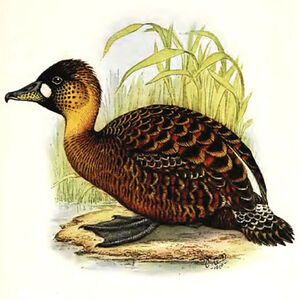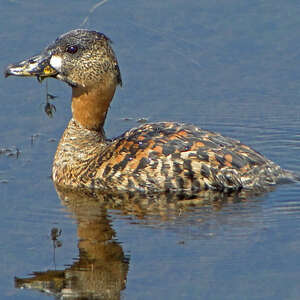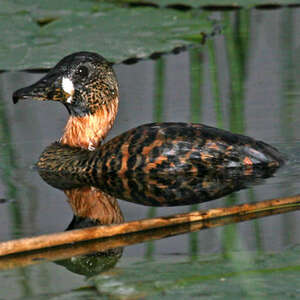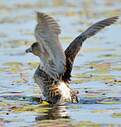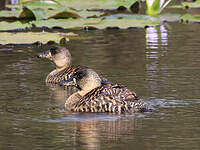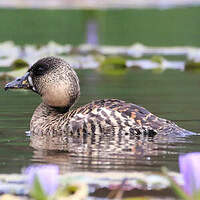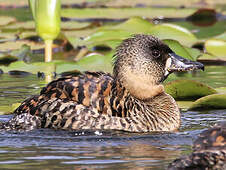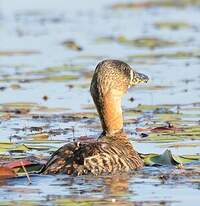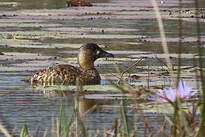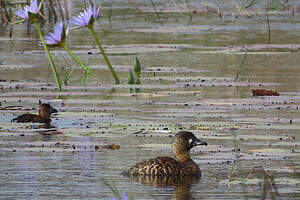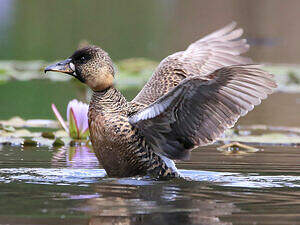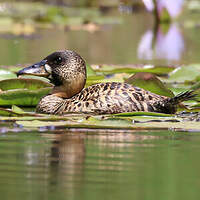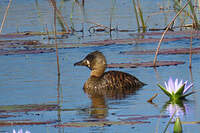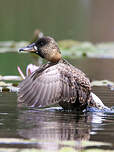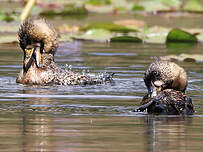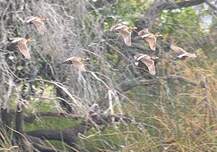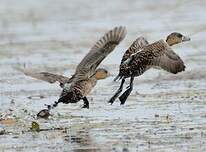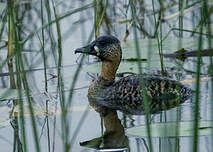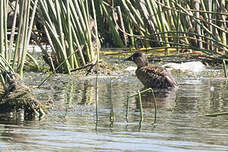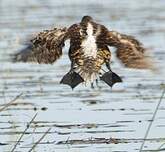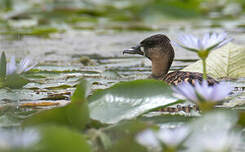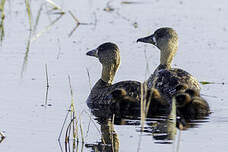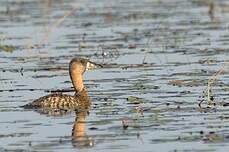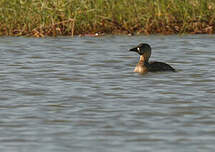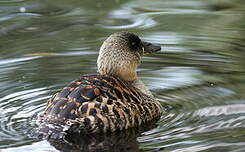White-backed Duck
Thalassornis leuconotus - Dendrocygne à dos blanc
Identification
Due to a certain resemblance with shovelers, the White-backed Duck was initially classified in the Oxyurinae. Today, it is considered more as a Dendrocygninae, the only representative of its genus. Hard to be confused with another duck, it could be mistaken with a grebe due to its particular colors. There is no sexual dimorphism even though males tend to be slightly bigger than females. The face is black-brown up to the eyes which stand out badly. Two white spots below the lores contrast strongly with the dark face and black-brown beak. This last one is more or less spotted with yellow and presents a strong lobe. The neck and sides of the head are chamois, the latter very speckled with black-brown. Dark and bristled feathers on the back of the crown and descending on the neck in a dark line occasionally give the bird a crested aspect. The rest of the body is covered with a plumage showing an able mixture of black-brown and beige-chamois which makes the bird very cryptic in a context of aquatic vegetation. A largely white back appears when the bird is in flight or when it splashes. The tail is extremely short. The legs are gray-greenish. The juvenile is similar to the adult but more dull. The white spots on both sides of the beak are also less visible. The insularis subspecies, smaller than the nominate one, reproduces itself in Madagascar. Its general aspect is darker.
Subspecific information 2 subspecies
- Thalassornis leuconotus leuconotus (e Cameroon to s Ethiopia and South Africa)
- Thalassornis leuconotus insularis (Madagascar)
Foreign names
- Dendrocygne à dos blanc,
- Pato dorsiblanco,
- pato-de-dorso-branco,
- Weißrücken-Pfeifgans,
- vöcsökréce,
- Witrugeend,
- Anatra dorsobianco,
- vitryggig and,
- Hvitryggand,
- stromárka jarabá,
- kačenka bělohřbetá,
- Lappedykkerand,
- lampisorsa,
- Witrugeend,
- ànec cabusset,
- pokraczka,
- Белоспинная утка,
- コシジロガモ,
- 白背鸭,
- 白背鴨,
Voice song and cries
Habitat
The White-backed Duck prefers fresh water. It can therefore be found on lakes, lagoons, marshes and wetlands as well as on flooded meadows forming wide pools. It is also not unusual to observe it on shallow rivers as long as there is enough depth and an abundant floating vegetation such as water lilies. In Madagascar, it prefers forest lakes up to 1300 metres in altitude. In Uganda it has been seen up to 1800 metres and even up to 3000 metres in Kenya.
Behaviour character trait
The White-backed Duck is a mainly sedentary bird. However, it is known to move during the rainy season to take advantage of newly formed shallow waters, as well as during the post-nuptial period.
Outside of the breeding season, groups of several hundred individuals can be seen on permanent water bodies. This small dabbling duck spends its time diving. With its large webbed feet located very far back on its body, it is well-adapted to living in the water. It spends little time on land. During the day, it dozes off among the lilies. Its activity is highest at dawn and at dusk. Its food is found mainly under the water, although it sometimes finds it at the surface. In case of danger, it flattens itself at the surface, flight being used only as a last resort. Non-territorial and monogamous pairs nest either separately or, in the most favorable spots, in loose groups.Flight
Dietfeeding habits
Reproduction nesting
The breeding season varies depending on the geographical location and can happen at any time of the year.
Nest construction is the responsibility of both sexes. It is placed very close to the edge of the water or even on the water. Floating vegetation then serves as an anchoring point. The place is ideal for protecting from predators and its main source of food is not far away. Occasionally, the pair can rehabilitate old grebe or cormorant nests. The materials used are aquatic plants, reeds, rushes, and tall grasses. An access ramp is also built to access the nest. In the form of a bowl, it measures 30 to 34 cm wide and 11 to 25 cm deep. The female lays 4 to 9 eggs of a glossy brown colour, a unique colour among waterfowl, at a rate of one egg per day. Up to 11 eggs in a nest have been recorded, probably laid by two females. Incubation, which is assumed by both sexes, lasts 29 to 33 days. The male mainly incubates during the day, the female at night. Adult change at the nest takes place after a brief call, with the replacer approaching the nest underwater to avoid being detected. Chicklets swim and dive on the day of hatching. At 27 days old, they are half the size of an adult. At 34 days, the plumage is complete, except for some remiges. At 55 days, they are fully developed. The adults accompany and protect them throughout this period. In case of attack, adults pretend to be hurt by adopting the broken wing attitude.Geographic range
The White-backed Duck has a wide distribution across Sub-Saharan Africa, but its presence is mainly concentrated in a large swath of the continent extending from the Sudan and Ethiopia to the south of the Cape and Madagascar. Elsewhere it is found sporadically along a narrow band extending from Senegal to the south of Chad, passing through Mali and northern Nigeria. It avoids equatorial forests. Despite its wide distribution, the species is never abundant. The species is renowned for its sedentary behaviour, however, local and seasonal nocturnal movements do occur, though they are poorly understood.
Threats - protection
IUCN conservation status
concern
in the Wild
threatened
evaluated
There is little information about the population of White-backed Duck. It is considered non-threatened but there are recent indications of a decline. It is not hunted since its flesh is not considered appetizing. The subspecies of Madagascar may be more vulnerable, but again there is no recent information on its status. Its disappearance from some areas where tilapia has been introduced has been noted. This vegetarian fish, the most consumed in the world, destroys aquatic vegetation necessary for the White-backed Duck wherever it lives. Agricultural development and the proliferation of water hyacinth can greatly reduce its habitat. Finally, there is a high mortality from fishing nets, such as in Lake Naivasha, Kenya. The population levels would be 10,000 to 25,000 birds for Africa and 2,500 to 5,000 birds for Madagascar.
Sources of information
- IOC World Bird List (v14.1), Gill, F and D Donsker (Eds). 2024-04-18.
- BirdLife International, BirdLife International
- HBW Alive,
- Birds of Southern Africa, Tony Roocroft
- The Birds of Africa Vol VIII : The Malagasy Region, Safford R. et Hawkins F.
Other sources of interest
 Specification sheet created on
23/07/2023 by Nathalie Santa Maria
Specification sheet created on
23/07/2023 by Nathalie Santa MariaTranslation by AI Oiseaux.net
published: 28-01-2017 - Updated: 08-02-2017
© 1996-2024 Oiseaux.net
- Accipitriformes
- Aegotheliformes
- Anseriformes
- Apodiformes
- Apterygiformes
- Bucerotiformes
- Caprimulgiformes
- Cariamiformes
- Casuariiformes
- Charadriiformes
- Ciconiiformes
- Coliiformes
- Columbiformes
- Coraciiformes
- Cuculiformes
- Eurypygiformes
- Falconiformes
- Galliformes
- Gaviiformes
- Gruiformes
- Leptosomiformes
- Mesitornithiformes
- Musophagiformes
- Nyctibiiformes
- Opisthocomiformes
- Otidiformes
- Passeriformes
- Pelecaniformes
- Phaethontiformes
- Phoenicopteriformes
- Piciformes
- Podargiformes
- Podicipediformes
- Procellariiformes
- Psittaciformes
- Pterocliformes
- Rheiformes
- Sphenisciformes
- Steatornithiformes
- Strigiformes
- Struthioniformes
- Suliformes
- Tinamiformes
- Trogoniformes

